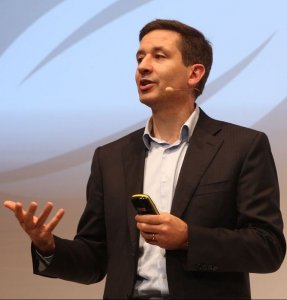To prevent overeating, we first tried information, but nutrition labelling and warnings haven’t had the desired impact, especially on the people who need help the most. Governments are now considering taxes, fines, and rules, which the industry doesn’t like because they are bad for business, and neither do consumers because it limits their choices.

Pierre speaks about how “Epicurean nudges” can help align health, business,and pleasure at TEDxINSEAD
The research on the behavioral science of eating that I’ve been conducting over the last 15 years, suggests that an alternative is possible. I call it Epicurean nudging, because it is entirely consistent with the teaching of Epicurus who, more than 2,300 years ago, said that the wise person doesn’t choose the largest amount of food, but the most pleasurable. The potential of Epicurean nudging is that it is possible to nudge people towards healthier, more profitable, and more enjoyable eating behaviors, thereby aligning the interests of governments, businesses, and citizens.
The key to Epicurean nudging is the realization that, although overeating is largely driven by the ever-increasing availability of large portions of food, almost all of the solutions focus on influencing what people eat—which is hard—instead of how much they eat—which is much easier. My research corrects this imbalance by studying the perception and choice of portion sizes. After studying the limits of food reformulation, I demonstrate that it is possible to make eaters happier to spend more for less food.
Health Halos: The Limitations of Food Reformulation
Removing salt, sugar, and fat, is part of the solution but my research has highlighted two important limitations. First, reformulation can create a misleading “health halo”, which can backfire and actually lead to overeating. For example, one of my studies found that labeling chocolate candies as “low-fat” led to a 46% consumption increase among overweight people compared to when they were labeled “regular”. This happened because a single health claim can lead people to categorize certain food as “healthy,” and thus conclude that they can eat more of it guilt-free and consequence-free.
Second, and more importantly, reformulation itself is rejected by a growing number of consumers, both from a hedonic and health perspective. As I demonstrate in another paper, there are four meanings of “healthy”, which vary depending on whether they focus on the presence of positives or the absence of negative attributes, and whether they are grounded in science or nature. Even when the four types of food claims are completely uncorrelated with actual nutrition quality, they still influence the food inferences and choices of consumers. For these reasons, food reformulation claims should only be mentioned when they fit the consumption goals of consumers (e.g., a low-calorie claim for dieters), or reformulation should be mentioned only after it has been implemented and accepted.
Less Size: Improving the Perception of Reasonable Portion and Package sizes
Food portions and packages have increased enormously. Forty years ago, a 16-ounce bottle of soda was advertised as large enough for three adults. Now, 16 ounces (or 50cl) is considered a normal single-serving by consumers. I have shown that part of why this happens is that supersized food portions look a lot smaller than they are. The underestimation of large portions can be very large. For example, despite accurately estimating the number of calories of small fast-food meals, people underestimated the number of calories of a 1,000-calorie meal by 25%. In another study, we showed people five transparent cups and told them that there were 37 chocolate candies in the smallest and asked them to guess how many were in the four remaining cups. Despite being incentivized for accuracy, people judged that the largest cup contained only 296 candies (vs. 592 in reality), missing half of the candies. The underestimation bias is related to portion size, not body size: people with a normal weight are as inaccurate as people who are overweight. Yet, it explains why energy intake is more strongly underestimated by obese people because they tend to eat—and thus estimate—larger meals. Perceived size increases more slowly than actual size for everyone: children as well as adults, professional chefs and dieticians as well as common folks.
The underestimation bias, and other biases in size impression, come from the fact that our senses are “bad at geometry”. Increasing the height, width, and length of any food package or portion by 26% is enough to double its volume (because 1.26^3=2). Yet, because our perception “adds” (rather than multiplies) these changes, we perceive a doubling to be only 50% to 70% bigger. This bias leads consumers to choose portions that are larger than they think and to refuse to pay a fair price for the extra quantity, leading to overeating and waste, a total lose-lose scenario.
All of these results suggest that companies and consumers should downsize portions down to what used to be their sizes twenty years ago. Downsizing would reduce intake and waste and can even increase profits if prices are not reduced proportionally. Why then is it so difficult to implement? I found that it is because people are much better at noticing size decreases than size increases. Going back to the chocolate candy study, when we told participants the number of candies in the largest cup, they were incredibly accurate when estimating the count of candies in the smaller portions. This happens because two reference points are available when estimating decreasing quantities: the original size and zero, given that quantities can never be negative.
An effective strategy to encourage people to prefer—and pay for—more reasonable portions is to add a smaller size to the range available. Because size perception is relative, adding a smaller size makes the old “small” a “medium”, making consumers more likely to buy it rather than larger sizes. Another approach is to brand sizes in a way that communicates volume, like Starbucks branding its smallest size, the “tall” cup. Finally, my research has shown that, rather than shortening food packaging and portions, elongating it by increasing its height while reducing its base masks size reduction and greatly facilitates downsizing. For example, we were able to downsize a product by 24% without people noticing, even when they were able to weigh the product by hand. The height appeared to compensate for the decrease in length and width, which our senses fail to multiply.
More Pleasure: Make the Sensory Experience of Eating Central Again
The second approach focuses on making people prefer to pay more for smaller portions. Most people choose large portions because they are good value for money and won’t leave them hungry, without considering how they will actually feel when eating them. People tend to forget that sensory pleasure peaks during the first few bites and then diminishes with each subsequent bite. More importantly, they do not realize that it is the last bite that determines the overall enjoyment of the food. Because pleasure in food is influenced by the average, not the sum, of the pleasure experienced in each bite, the last bite of a large portion actually reduces eating enjoyment. Hence, people often eat portions that are too large from a pleasure standpoint.
To put eating enjoyment back at the center of portion size decisions, a simple solution is to ask people to remember the sensory experience that they had when eating hedonic food. Across many studies, this simple intervention led school children, French and American adults, and restaurant customers to choose the smaller portions of desserts that were actually the best size for eating enjoyment. Fat and calorie information also made people choose smaller desserts but feel bad about it, reducing their willingness to pay for the experience. In contrast, sensory menu descriptions made people choose smaller portions and feel good about it, making them willing to pay more for less food. That’s a triple win for health, business, and eating pleasure.
Pierre recently took part in a talk at TEDxINSEAD on the topic. Find out more and watch the TED talk.
*For more information on the studies referenced in the blog, please visit www.pierrechandon.com
Pierre Chandon
The L’Oréal Chaired Professor of Marketing—Innovation and Creativity
Director of the INSEAD-Sorbonne University Behavioral Lab

